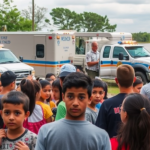TSTC Cybersecurity Students Join Forces with Drafting and Design Program for Virtual Competition
In a collaborative initiative poised to elevate the academic and professional landscape of the Rio Grande Valley (RGV), Texas State Technical College’s (TSTC) Cybersecurity students are receiving pivotal assistance from the college’s Drafting and Design program as they prepare for an upcoming virtual competition. This partnership highlights the growing intersection of technology and design, emphasizing the local impact on educational excellence and workforce readiness in South Texas.
Enhancing Web Experiences with JavaScript and Cookies
Central to this collaboration is a deep understanding of JavaScript and cookies—two essential components driving today’s web environments. JavaScript, a versatile scripting language, enables dynamic content and interactive features. It powers everything from animations to form validations on websites, ensuring users encounter vibrant, interactive interfaces. On the other hand, cookies serve as small data files stored on local devices, allowing websites to remember user-specific information. This personalization improves performance by maintaining user sessions and storing preferences, though it raises valid concerns about privacy and security.
“It’s crucial for students in cybersecurity to grasp how web technologies like JavaScript and cookies function, as these elements significantly influence both user experience and security measures,” explains Miguel Hernandez, a faculty member in the Cybersecurity department at TSTC. “Understanding these components will give our students a competitive edge, not only in competitions but in their future careers.”
Local Impact: Bridging Education and Industry
For Valley residents, the practical implications of this collaboration are considerable. As the digital landscape continues to evolve, there is an increasing demand for professionals adept in both cybersecurity and web technologies. By integrating insights from the Drafting and Design program, Cybersecurity students can amplify their skills, addressing both security challenges and usability concerns inherent in web applications. This initiative not only prepares students for competitions but also equips them with crucial proficiencies needed in today’s job market.
“The RGV is becoming a burgeoning hub for tech innovation, with institutions like TSTC leading the charge. By equipping students with cross-disciplinary skills, we are setting them up for success in competitive industries,” states Rebecca Cruz, a coordinator at the college’s Career Services.
Connecting the Dots: Previous and Ongoing Efforts
This initiative is part of TSTC’s broader efforts to bolster the region’s educational ecosystem. Historically, the college has been at the forefront of programs catering to regional industries’ needs, ensuring that students receive relevant and robust training. The collaboration between the Cybersecurity and Drafting and Design programs is a natural progression of this mission, building upon previous successful partnerships and projects.
Justin Torres, a third-year student in the Cybersecurity program, recalls when TSTC organized tech symposiums bringing together students, faculty, and local tech companies. “Those events opened many doors for us, providing insight into real-world applications of what we learn. This current project only deepens those connections,” he remarked.
Future Prospects and Broader Implications
Looking ahead, such interdisciplinary collaborations could usher in new educational models within the RGV, enhancing both academic offerings and community interest in technology-driven careers. As students dive deeper into the mechanics of web functionalities like JavaScript and cookies, they become better prepared to tackle emerging tech challenges and contribute to the economic vibrancy of South Texas.
However, some stakeholders propose cautious optimism, emphasizing the need for sustainable expansion in academic programs that directly correlate with local economic needs. “While fostering tech expertise is crucial, we must ensure these initiatives correlate with tangible job opportunities in the Valley, avoiding talent drain to other regions,” comments Dr. Lucia Perez, an economist specializing in regional development.
Balancing Educational Initiatives with Privacy Concerns
While this partnership illuminates the positive trajectory of tech education in the Valley, it also brings to the forefront essential discussions about digital privacy and data security—a central concern in the use of cookies. As future tech professionals, TSTC students are encouraged to navigate these ethical considerations adeptly, finding a balance between innovation and user privacy.
For those within the community seeking more information or engagement options regarding this initiative, TSTC plans to host virtual seminars where faculty and students will discuss their work and its implications. Additionally, resources are available for high school students interested in pursuing careers in technology at the college.
Indeed, while technology continues to shape the educational and professional landscape, the Rio Grande Valley stands at an exciting juncture. It is driven by proactive educational strategies and community engagement—a promising sign of the region’s adaptability and forward-thinking ethos.







